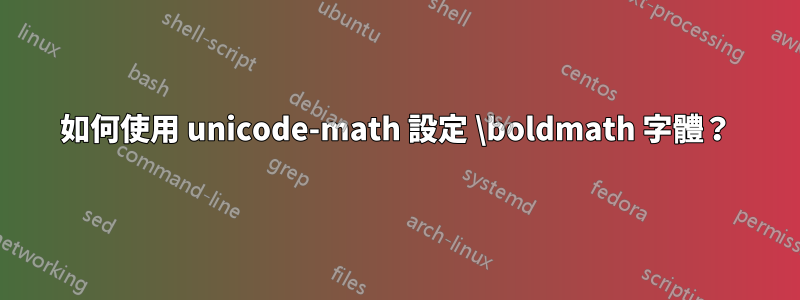
我正在嘗試在 Linux Libertine 中排版文檔,我也想在數學模式下使用該字體來表示字母數字字元。我正在使用unicode-math,而不是mathspec,因為我需要mathup明確指定字母表以與hepnames.我沒有找到一種方法來做到這一點mathspec。我使用的引擎是XeLaTeX。我最初將 TeX Gyre Pagella Math 指定為符號等的完整數學字體。
我發現了幾個問題,如下面的 MWE 所示:
- 開關
\boldmath沒有任何作用。 - 數字無法正確呈現為粗體和斜體,只有字母。
\mathbf(MWE 中的最後一個「A = 1」)是在 Pagella 中渲染的,而不是在 Libertine 中渲染的。
我已經嘗試添加/{latin,Latin,num}到range聲明中,但沒有成功。我在這裡缺少什麼?
\documentclass{minimal}
\usepackage{fontspec}
\usepackage{unicode-math}
\setmainfont[%
Ligatures=TeX,
BoldFont=LinLibertine_RB.otf,
ItalicFont=LinLibertine_RI.otf,
BoldItalicFont=LinLibertine_RBI.otf]
{LinLibertine_R.otf}
\setmathfont{texgyrepagella-math.otf}
\setmathfont[range=\mathup]{LinLibertine_R.otf}
\setmathfont[range=\mathbf]{LinLibertine_RB.otf}
\setmathfont[range=\mathit]{LinLibertine_RI.otf}
\setmathfont[range=\mathbfit]{LinLibertine_RBI.otf}
\begin{document}
\begin{tabular}{lll}
Text & A = 1 & \textit{B = 2}\\
Textbf & \textbf{A = 1} & \textbf{\textit{B = 2}}\\
Math & $A = 1$ & $\mathit{B = 2}$\\
Boldmath & {\boldmath $A = 1$} & {\boldmath $\mathit{B = 2}$}\\
Mathbf & $\mathbf{A = 1}$ & $\mathbfit{B = 2}$\\
\end{tabular}
\end{document}

不改變字體,一切看起來都正常:
\documentclass{minimal}
\begin{document}
\begin{tabular}{lll}
Text & A = 1 & \textit{B = 2}\\
Textbf & \textbf{A = 1} & \textbf{\textit{B = 2}}\\
Math & $A = 1$ & $\mathit{B = 2}$\\
Boldmath & {\boldmath $A = 1$} & {\boldmath $\mathit{B = 2}$}\\
\end{tabular}
\end{document}

答案1
我找到了一個適合我的解決方案。version=bold正如大衛建議的那樣,我開始玩弄,但情況一直在變化全部我的數學模式文字粗體。最後我從檔案名稱切換到系統字體名稱。 (我最初想避免這種情況,因為我正在幾台不同的機器上處理同一個文件。)使用系統字體名稱,可以\boldmath 立即自動工作。我還發現\mathbfup必須指定而不是\mathbf.
使用系統字體名稱的另一個問題是,由於某種原因,半粗體 Libertine 樣式預設載入為粗體。這就是BoldFont在下面的 MWE 中進行規範的原因。
該解決方案並不完美。您可以看到數學模式下的所有數字都是直立呈現的,即使在\mathit.另外,其中的數字\mathbfit不是粗體。不過所有字體都是正確的,對於我的目的來說已經足夠了。
\documentclass{minimal}
\usepackage{fontspec}
\usepackage{unicode-math}
\setmainfont[
BoldFont=Linux Libertine Bold,
BoldItalicFont=Linux Libertine Bold Italic]
{Linux Libertine}
\setmathfont{TeX Gyre Pagella Math}
\setmathfont[range=\mathup,
BoldFont=Linux Libertine Bold,
BoldItalicFont=Linux Libertine Bold Italic]
{Linux Libertine}
\setmathfont[range=\mathit,
BoldFont=Linux Libertine Bold Italic]
{Linux Libertine Italic}
\setmathfont[range=\mathbfup]{Linux Libertine Bold}
\setmathfont[range=\mathbfit]{Linux Libertine Bold Italic}
\begin{document}
\begin{tabular}{lll}
~ &\ Regular &\ Italic\\
Text &\ A = 1 &\ \textit{A = 1}\\
Textbf &\ \textbf{A = 1} &\ \textbf{\textit{A = 1}}\\
Math &\ $A = 1$ &\ $\mathit{A = 1}$\\
Boldmath &\ {\boldmath $A = 1$} &\ {\boldmath $\mathit{A = 1}$}\\
Mathbf &\ $\mathbf{A = 1}$ &\ $\mathbfit{A = 1}$\\
\end{tabular}
\end{document}

答案2
tg85 指出他對自己的問題所提供的答案有兩個問題:
該解決方案並不完美。您可以看到數學模式下的所有數字都是直立呈現的,即使在
\mathit.另外,其中的數字\mathbfit不是粗體。不過所有字體都是正確的,對於我的目的來說已經足夠了。
這unicode 數學手動的(圖 7)指出,直立形狀實際上是專門為數字選擇的,因為它們「即使是斜體樣式,也應始終取自直立字體」。與此聲明一致,Unicode 似乎沒有為斜體數字定義插槽,但它為粗體數字、無襯線數字等定義了插槽。https://en.wikipedia.org/wiki/Mathematical_operators_and_symbols_in_Unicode#Mathematical_Alphanumeric_Symbols_block。
不過,我可以理解,人們仍然希望由unicode 數學為了與原始的基於 LaTeX 的排版保持一致,其中\mathit{1}產生斜體數字 1。因此,受到啟發tg85 的代碼,我想出了一個解決這兩個問題的解決方案(也適用於 LuaLaTeX):
% !TEX program = xelatex
\documentclass{minimal}
\usepackage{ifthen}
\usepackage[svgnames]{xcolor}
\usepackage[
mathit = sym, mathup = sym, mathbf = sym,
math-style = ISO, bold-style = ISO
]{unicode-math}
\setmainfont{LinLibertine_R.otf}[
ItalicFont = LinLibertine_RI.otf,
BoldFont = LinLibertine_RB.otf,
BoldItalicFont = LinLibertine_RBI.otf
]
\setmonofont{FiraMono-Medium.otf}[
Scale = 0.81,
Color = DarkBlue
]
\setmathfont{XITSMath-Regular.otf}[
BoldFont = XITSMath-Bold.otf
]
\setmathfont{XITSMath-Regular.otf}[
version = mathitVersion
]
\setmathfont{XITSMath-Regular.otf}[
version = mathbfitVersion
]
\setmathfont{XITSMath-Bold.otf}[
version = boldmathVersion
]
\setmathfont{LinLibertine_R.otf}[
range = up/{num, latin, Latin, greek, Greek},
BoldFont = LinLibertine_RB.otf
]
\setmathfont{LinLibertine_RI.otf}[
range = it/{num, latin, Latin, greek, Greek},
BoldFont = LinLibertine_RBI.otf,
NFSSFamily = mathitalic
]
\setmathfont{LinLibertine_RBI.otf}[
range = bfit/{latin, Latin, greek, Greek},
NFSSFamily = mathbolditalic
]
\setmathfont{LinLibertine_RB.otf}[
range = bfup/{num, latin, Latin, greek, Greek}
]
\newif \ifBoldMath \BoldMathfalse
\let \mathversionorig \mathversion
\renewcommand{\mathversion}[1]{%
\ifthenelse{\equal{#1}{bold}}{%
\BoldMathtrue%
}{%
\BoldMathfalse%
}%
\mathversionorig{#1}%
}
\AtBeginDocument{%
\let \mathitorig \mathit%
\renewcommand{\mathit}[1]{%
\ifBoldMath%
\textbf{%
\SetSymbolFont{__um_fam1}{boldmathVersion}{TU}{mathbolditalic}{b}{it}%
\SetSymbolFont{__um_fam2}{boldmathVersion}{TU}{mathbolditalic}{b}{it}%
\mathversion{boldmathVersion}%
\(\mathitorig{#1}\)%
}
\else%
\textit{%
\SetSymbolFont{__um_fam1}{mathitVersion}{TU}{mathitalic}{m}{it}%
\mathversion{mathitVersion}%
\(\mathitorig{#1}\)%
}%
\fi%
}%
\let \mathbfitorig \mathbfit%
\renewcommand{\mathbfit}[1]{{%
\textbf{%
\SetSymbolFont{__um_fam1}{mathbfitVersion}{TU}{mathbolditalic}{b}{it}%
\mathversion{mathbfitVersion}%
\(\mathbfitorig{#1}\)%
}%
}}%
}
\newcommand{\testUnicodeMath}{%
\bigskip
\begin{tabular}{l @{\quad}l @{\quad} l @{\quad} l @{\quad} l}
Row
& Math version/alphabet
& Regular
& Upright
& Italic \\[\medskipamount]
1
& Text
& A = 1a
& \textup{B = 2b}
& \textit{C = 3c} \\
2 &
\texttt{\textbackslash textbf}
& \textbf{A = 1a}
& \textbf{\textup{B = 2b}}
& \textbf{\textit{C = 3c}} \\
3
& \texttt{\textbackslash mathversion\{normal\}} (default)
& $A = 1a + \beta \times \Gamma \int_{-\infty}^{\infty} \frac{\mathup{d}x}{2}$
& $\mathup{B = 2b + \beta \times \Gamma}$
& $\mathit{C = 3c + \beta \times \Gamma}$ \\
4
& \texttt{\textbackslash mathversion\{bold\}}/\texttt{\textbackslash boldmath}
& \boldmath $A = 1a + \beta \times \Gamma \int_{-\infty}^{\infty} \frac{\mathup{d}x}{2}$
& \boldmath $\mathup{B = 2b + \beta \times \Gamma}$
& \boldmath $\mathit{C = 3c + \beta \times \Gamma}$ \\
5
& \texttt{\textbackslash mathbf}/\texttt{\textbackslash mathbfup}/\texttt{\textbackslash mathbfit}
& $\mathbf{A = 1a + \beta \times \Gamma \int_{-\infty}^{\infty} \frac{\mathup{d}x}{2}}$
& $\mathbfup{B = 2b + \beta \times \Gamma}$
& $\mathbfit{C = 3c + \beta \times \Gamma}$ \\
\end{tabular}%
\bigskip
\bigskip
}
\begin{document}
\testUnicodeMath
\textit{Check that everything works properly by invoking it a~second time:}
\testUnicodeMath
\textit{Check that everything works properly by invoking it a~third time:}
\testUnicodeMath
\end{document}
這會產生以下輸出 - 請注意,表第 3 行中的「3」現在是斜體,表第 4 行和第 5 行中的「3」是粗體斜體:
\mathversion{bold}另請注意/\boldmath和\mathbf/ \mathbfup/之間的對比\mathbfit:前者還使所有運算符、積分等變為粗體,而後者僅影響字母和數字。
答案3
使用包 amsbsy 和 \pmb 似乎得到了粗體。
\documentclass{minimal}
\usepackage{fontspec}
\usepackage{unicode-math}
\usepackage{amsbsy}
\setmainfont[%
Ligatures=TeX,
BoldFont=LinLibertine_RB.otf,
ItalicFont=LinLibertine_RI.otf,
BoldItalicFont=LinLibertine_RBI.otf]
{LinLibertine_R.otf}
\setmathfont{texgyrepagella-math.otf}
\setmathfont[range=\mathup]{LinLibertine_R.otf}
\setmathfont[range=\mathbf]{LinLibertine_RB.otf}
\setmathfont[range=\mathit]{LinLibertine_RI.otf}
\setmathfont[range=\mathbfit]{LinLibertine_RBI.otf}
\begin{document}
\begin{tabular}{lll}
Text & A = 1 & \textit{B = 2}\\
Textbf & \textbf{A = 1} & \textbf{\textit{B = 2}}\\
Math & $A = 1$ & $\mathit{B = 2}$\\
Boldmath & { $\pmb{A = 1}$} & {$\pmb{\mathit{B = 2}}$}\\
Mathbf & $\mathbf{A = 1}$ & $\mathbfit{B = 2}$\\
\end{tabular}
\end{document}

答案4
與xelatex或lualatex
\documentclass{standalone}
\usepackage{hepparticles}
\usepackage{hepnames}
\usepackage[math-style=ISO]{unicode-math}
\usepackage{libertinus}
\usepackage{array}
\begin{document}
\tabcolsep=10pt
\begin{tabular}{>{\ttfamily\textbackslash}lll}
normalfont & Regular &\itshape Italic\\
textnormal & A = 1 & \textit{A = 1}\\
textbf & \textbf{A = 1} & \textbf{\textit{A = 1}}\\
mathup & $\mathup{A} = 1$ & $A = 1$\\
symbf & $\symbfup{A = 1}$ & $\symbfit{A = 1}$\\
mathbf & $\mathbf{A = 1}$ & $\mathbfit{A = 1}$\\
\end{tabular}
\end{document}




